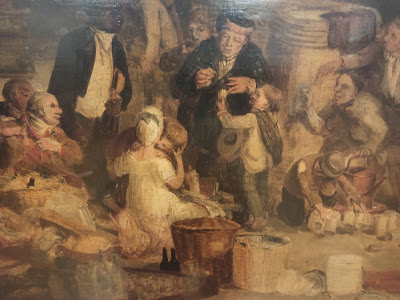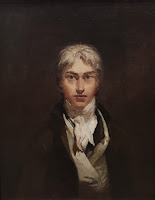Edit: This post is part of a series to exploring my visit to the Turner's gallery at the Tate Britain. I like to write about the paintings, jot down my thoughts in this blog, and explore some background reading.
- Part 1 - Turner's Europe
- Part 2 - Turner's Britain
- Part 3 - Turner's Seascapes
- Part 4 – Turner's Exhibitions
✲✲✲
I’ve been to the Tate Gallery exhibition on Joseph Mallord William Turner. See self-portrait below. He gave himself some penetrating features, the eyes, ruffled hair etc.
This blog will focus on a handful of paintings concerning Britain.
Turner is really amazing. It is easy to get lost in his work. What’s striking about his exhibition are the sheer number of paintings on display. He must have been a juggernaut of an artist. He completely dominates a wing of the Tate Gallery.
From what I’ve read, he was a romanticist. From my modest readings of English literature, I’m aware of romanticism as an early 19th century artistic movement in reaction to realism and the Enlightenment. Romanticism pivoted away from the scientific explanations of the world, the methodical and technological (as, presumably, inert and remote) and focused on exalting nature, spirituality, and that sense of wonder. I’m curious to uncover the difference between romanticism and classicism.
For me, what is incredible is the sheer detail and delicacy that animate his paintings. They are are full of the bustling energy life. Sometimes, they evoke a sense of the awe or foreboding – either in their turmoil or serenity – by harnessing the elements of nature which tower over the viewer.
✲✲✲
Crossing the Brook (1805)
 |
| Crossing the Brook. |
There is an idyllic warmth and charm to this painting.
The dayshine illuminates the edge of a calm lake and brings into focus the easy-going pace of life with a sweet schnauzer being playfully beckoned. If you look closely, you can descry a flipflop suspended in the canine’s mouth as it gives chase (see detailed image below).
It’s these sorts of details that enliven the painting. As I hope you’ll notice, Turner really loves to embellish paintings with little subtle details and minutia that reflect the charm of everyday life.
In this painting, a lass gazes nonchalantly into the lake with a sack of shopping resting to her side. In the background, the radiant sun enlivens an arcadian vista.
There are faint mills and windmills, an elegant classical bridge on which someone saunters, the outline of the uppermost of a sailboat as it meanders a river, and of course lush verdure and forestry over yonder.
According to the Tate:
The painting was exhibited in the year of the battle of Waterloo. Viewers at the time would have been alert to the patriotic subtext of such an imposing depiction of the British landscape.
 |
| Very sweet. Click the photo for larger dimensions. |
✲✲✲
The Quiet Ruin, Cattle in Water (1809)
 |
| The Quiet Ruin, Cattle in Water. |
It’s hard not to smile or feel uplifted at such a sight, especially the calf following, and caressing, its mother as they approach the lagoon.
The overall scheme of colours and luminance is balanced and harmonious. The background is abstracted and indistinct. The viewer is focused into the middle: a herd of cows.
I think this sort of scene is beautiful because of what it represents to us. Cows are part of folklore and children’s stories. They aren’t merely a staple of farm life but represent human wellbeing as beef or dairy cattle.
The source of fresh and clean water to drink with the attendant grassy patches in the landscape suggests food crops and nourishment.
The open spread-out area attests to the lack of danger, and the mountains which form a protective wall.
It’s instructive that this was painted – as with so many others – during the Napoleonic Wars (1803–1815).
✲✲✲
St Mawes at the Pilchard Season (1812)
 |
| St Mawes at the Pilchard Season. |
The village of St Mawes was (and is) a small fishing town in Cornwall. According to the Tate:
Napoleon’s Continental Blockade meant countries allied with France could not trade with the British. It prevented excess fish caught in British waters being exported to mainland Europe.
The striking thing about this painting is the sheer hustle bustle of the community. The centre is dominated by shovelling, carrying and lifting etc. And yet, the romantic elements contrast with the pathos and realism that underlies the painting. In this case, namely, the effect of an economic blockade on a town dependent on that industry.
This painting shows – not despair and gloominess – but a community rolling-their-sleeves and getting on with life. There’s no weeping or any acts of despondency. It’s a painting of some defiance as opposed to resignation and defeat.
In the direction of the sea, Turner’s clouds bedarken the atmosphere and obnubilate the way. But, in the opposite direction, Cornwall’s shoreline is commanded by an English castle perched on a steep rocky headland. Indeed, the clouds begin to part in the skies above the castle to expose the azure heavens on the English coast.
Turner is a virtuoso in the power of light and illumination. The artful use of light and shadow (and the penumbra) creates a candescence and liveliness to the scene.
 |
| A family. |
The details are fascinating here. Firstly, there is the posture of the fisherman (in the black apparel). The way his back leans forward from the weight of the basket. He even looks like he’s balancing the basket on his knees momentarily as he releases his foot off the boat’s gunwale.
Then, there are the two children on the floor by the bow. I think their coats are laid on the container just behind them, and the boy (with a black knife in hand) is about to gut a fish. His sister is leaning forward watching him do it. I wonder if Turner made the kneeling lady adjacent to them their mother (and, if so, is that fisherman their father?). It’s a charming little detail.
✲✲✲
Harvest Home (1809)
 |
| Harvest Home |
This is an unfinished painting. According to the Tate:
It probably depicts a harvest meal on the Earl of Essex's Hertfordshire estate, Cassiobury Park. The smartly dressed black man standing on the left of the composition is George Edward Doney, the Earl’s butler.
Once again, the hustle bustle of life. People waving, talking, sauntering in with a bottle in hand, etc. There’s someone in a straw hat sitting aloft. To the left, a table with a few men around. A woman leading a child away. A few dogs. Bottles and glasses around. It’s an obvious celebration of sorts. It’s a shame this painting wasn’t finished as the foreground is barren.
 |
| The Earl, his butler, and the vampire. |
Some curious details. The Earl’s butler (the black man) with a bottle in hand and something rolled up under his arm. The Butler (presumably) looks like he’s paying for something. Then, there are the two girls. It is either a vampire sucking the girl’s blood, or another girl whispering a secret. There’s something sinister about that face and the arm lifted to push him/her away. So, it might be a vampire? Don’t forget the pile of cutlery, plates and empty bottles.
✲✲✲
View of Richmond Hill and Bridge (1808)
Turner bathes the bridge in aureate light. It’s clear and distinct whereas the environment is a bit vague and murky. The ladies – with a baby being lifted and held closely – are the only part of the nebulous earthy foreground that’s radiating. The river’s motion is so smooth and undisturbed that it adds to that sense of calm and idyllic peace.
I think I've actually seen this bridge in Richmond which is exciting.
✲✲✲
Cliveden on Thames (1807)
Once again, Turner loves his clouds, moving waterways with reflections, farm animals, a charming abode and forestry and greenery.
The Tate refers to the painting’s “imprecise, atmospheric style”. It seems that the lake has receded. The cows are ambling through, and their legs are exposed. The canal boat seems to be heading to shore (the large home probably).
This painting has an autumnal feel, but it does feel a bit warm and muggy. There is a lack of grass on the shore by the lake.




No comments:
Post a Comment